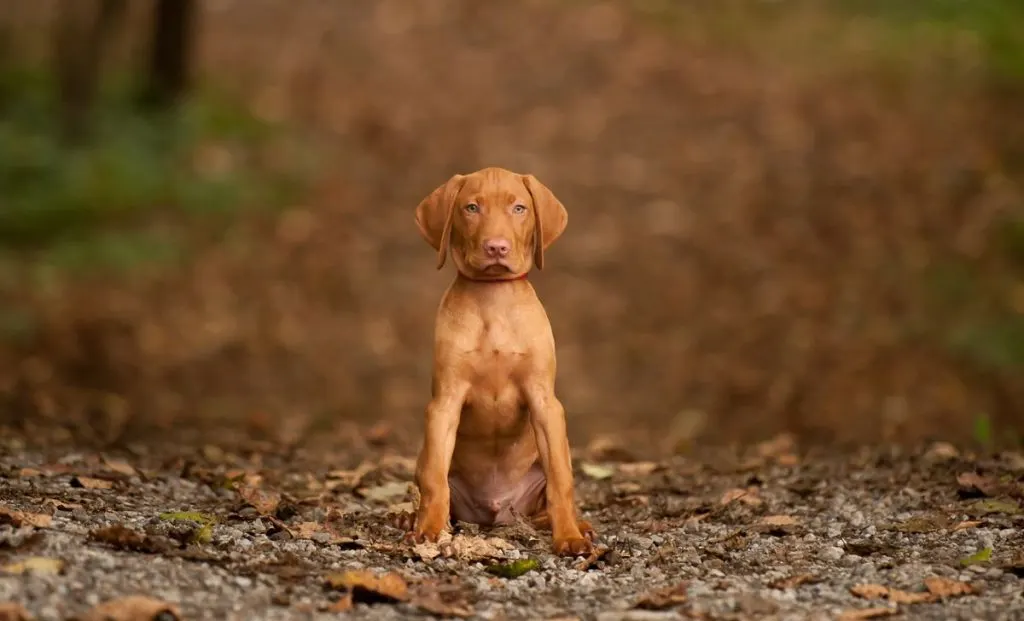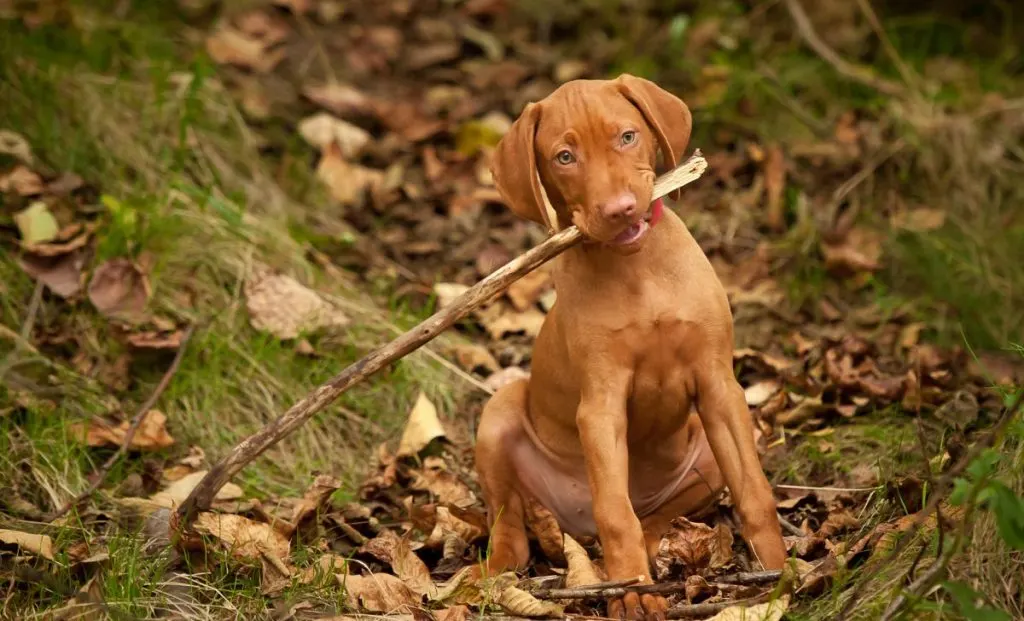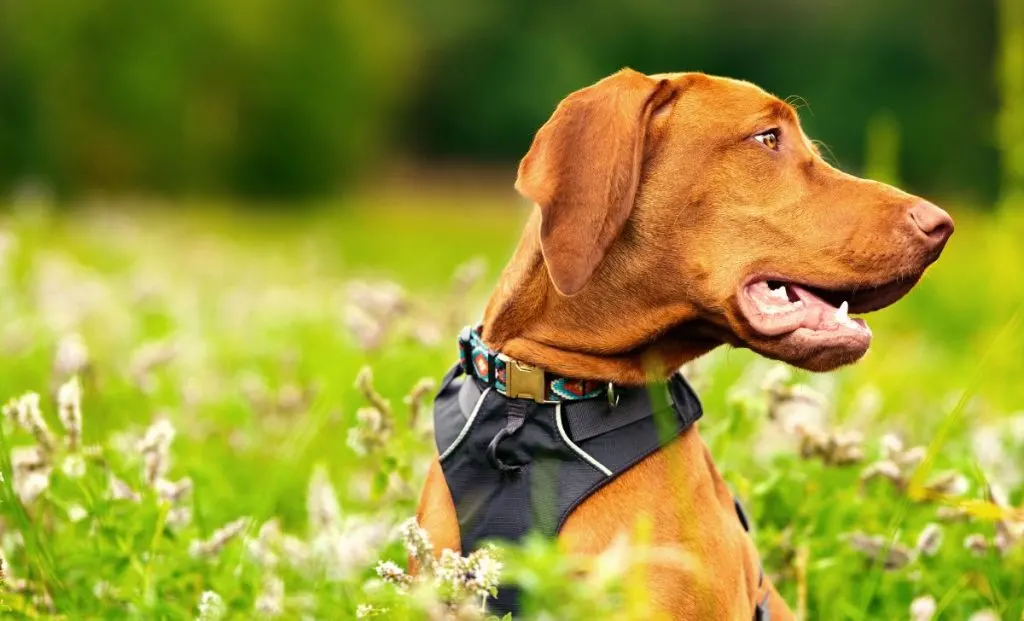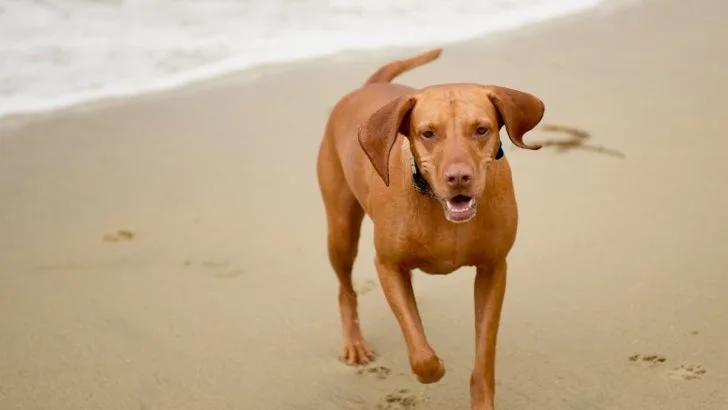If you’ve just welcomed a Vizsla puppy into your home, or you’re planning to, you’re probably curious about how quickly they’ll grow from a tiny fur ball into a full-sized companion.
This Vizsla growth chart is your go-to guide for understanding the milestones in your pup’s development.
So, let’s grow together!
Vizsla Growth Chart Overview
Let’s first check an overview of the Vizsla weight chart. This is a general idea of what to expect as you scroll through the article.
| Age (Months) | Weight (lbs) | Weight (kg) |
| Birth | 1 – 2 | 0.45 – 0.9 |
| 1 | 2 – 4 | 0.9 – 1.8 |
| 2 | 10 – 15 | 4.5 – 6.8 |
| 3 | 15 – 20 | 6.8 – 9.1 |
| 4 | 20 – 30 | 9.1 – 13.6 |
| 6 | 30 – 40 | 13.6 – 18.1 |
| 8 | 40 – 50 | 18.1 – 22.7 |
| 10 | 45 – 55 | 20.4 – 24.9 |
| 12 | 45 – 65 | 20.4 – 29.5 |
| Approximate Height (inches) | Height (cm) |
| – | – |
| 6 – 8 | 15 – 20 |
| 10 – 12 | 25 – 30 |
| 12 – 14 | 30 – 35 |
| 14 – 16 | 35 – 40 |
| 16 – 18 | 40 – 45 |
| 18 – 20 | 45 – 50 |
| 20 – 22 | 50 – 55 |
| 21 – 25 | 53 – 63 |
It’s important to remember that these values are estimations. Each Vizsla dog is unique and will grow at its own pace, so the actual sizes may vary.
This is appropriate when connected to how one uses the Vizsla growth chart. This relates to how important researchers have cited growth charts as tools in monitoring the growth and health of dogs (1).
It is a good idea to keep this in mind as you follow the growth of your own spirited Vizsla!
Vizsla Standards Around The World
Vizsla breed standards vary slightly depending on location, with differences noted particularly between European, Australian, and American standards.
Generally, European and Australian Vizslas tend to be slightly larger in size compared to their American counterparts.
According to the American Kennel Club (AKC) Hungarian Vizsla Standard, females ideally stand between 21 to 23 inches at the shoulders, while males are ideally 22 to 24 inches tall. Deviations of 1.5 inches above or below these measurements are disqualified.
In Australia, the Hungarian Vizsla standard allows for a slightly broader range, with females ideally ranging from 21 to 24 inches (54 cm to 60 cm ) and males from 23 to 25 inches (58 cm to 64 cm). Deviations of 2 cm above or below these measurements are disqualified.
Similarly, the UK Hungarian Vizsla standard also presents a range of measurements. Females are ideally 21 to 24 inches (53 cm to 60 cm), while males range from 22 to 25 inches (57 cm to 64 cm).
As with the Australian standard, deviations of 2 cm above or below these measurements are grounds for disqualification.
Vizsla Puppy Growth Chart
Alright, now that we are aware of the major differences in weight and height within the Vizsla breed, let’s see how these puppies actually develop throughout time.
Get ready, we are taking you on a journey of Vizsla puppyhood!
Birth – 4 Weeks

The early stages of a Vizsla puppy’s life are both delicate and crucial for their development.
During their very first week, Vizsla puppies are born blind and deaf! Like all newborn mammals, they are completely reliant on their mother for warmth, protection, and nutrition.
One cannot underestimate the treasure trove of nutrients found in colostrum — the first milk produced by the dog mother.
In the initial days, colostrum is vital as it provides essential immunoglobulins, lipids, and carbohydrates. These nutrients play a critical role especially in the first two weeks, acting as the building blocks for the puppy’s immune system and overall health (2).
For a Vizsla, a breed known for its hunting prowess and active lifestyle, such foundational health support is of the utmost importance!
At this stage, the mother is also the primary source of comfort and security.
The European Vizslas, like all dogs, exhibit a strong maternal instinct.
However, it’s important to note that under stressful conditions or due to physical trauma, mother dogs might harm their puppies, though such cases are rare.
1 – 2 Months

The period from 1 to 3 months is a fascinating stage in the life of a Vizsla puppy! Quite a lot happens within this timeframe. It is characterized by rapid growth, exploration, and learning.
At around one month old, Vizsla puppies undergo an important transition — their teeth start growing and they begin the weaning process. Teething will be an ongoing thing for the next seven months, so get ready for that!
This shift in dietary needs ensures they receive all the necessary nutrients to grow to an impressive adult size. Well, not as big as the Anatolian Shepherd or other shepherd dogs.
They learn the basics of canine communication and bite inhibition. It is not uncommon to hear a sharp scream or notice a playful nip among the littermates.
By the second month, Vizsla puppies are usually ready for their first series of vaccinations, as recommended during vet visits. This is also when their dietary needs become more demanding.
Now is also a good time to introduce basic commands and housebreaking. During this time, pups experience a burst of cognitive development!
They are like little sponges, absorbing the knowledge at an extremely fast pace! The perfect time for first-time dog owners to start training sessions.
These sessions should be short, consistent, and filled with plenty of encouragement, helping the puppies understand basic commands and house rules.
2 – 3 Months

Entering the third month, Vizsla puppies become noticeably more independent and energetic.
This increased independence is a double-edged sword though. Sure, allows for more engaging training sessions, like longer runs and trail runs for those with large paws.
But, it also means puppies might test boundaries more frequently. In other words, they are becoming teenagers!
At this period, regular social interactions with humans and other dogs are a must. This way you teach them about various social behaviors and help them develop into well-adjusted adult dogs.
Now, teething is becoming quite a burden around this age too. This makes it a potentially hard time for puppies as they deal with lots of discomfort.
Prepare to visit your pet shop again and find some good chew and squeaky toys that can help soothe their gums. It will also help them develop proper chewing habits (3).
Psst, these toys will also protect your belongings from becoming chew targets!
Vizsla pups can start experiencing separation anxiety as early as when they begin to understand their environment and form attachments, typically around 8 to 10 weeks of age.
As you may have guessed, this period lays the groundwork for both the physical stature and the Vizsla personality traits that these sensitive breeds are known for.
3 – 4 Months

At 3 months, these little bundles of joy are becoming more independent and their personalities are becoming more distinct.
Increased energy and curiosity is how I would best describe this period for Vizslas. Of course, continued socialization and training are still a must. We are just getting started!
And if, as a first-time owner, you are not sure you are doing the right job, don;t shy away from puppy classes! These are often recommended at this age to help with social skills, learning commands, and basic obedience.
Around 4 months, intense teething becomes a major issue. As long as these pups have something to chew on, they are going to be happy!
They are growing fast! Vizslas’ dog’s weight is now between 15 to 20 lbs and height 12 to 14 inches tall. This is normal, as you do not expect them to grow into large, big dogs.
4 – 6 Months

This period is vital for continued socialization and training, which are essential in molding the Vizsla personality.
Puppies may begin to intensively assert their independence around this time. This is why consistent training with commands and boundaries through positive reinforcement is necessary.
It’s also crucial to continue socializing them actively. You can include playdates with other dogs, visits to various places, and even short walks in new environments. This will help the puppies learn how to interact appropriately with both humans and other dogs.
But, be careful when going out in nature. Vizsla pups are very curious and they might eat a bee or get hurt chasing prey.
With such high energy levels, these pups need a balanced diet that will help fuel their growing bodies.
It is also important to note that 6 month old females are on the smaller side, when compared to the big boys. This is also why they may need fewer calories than males.
6 – 12 Months

Moving into adolescence, Vizsla puppies often show more complex behavioral patterns due to hormonal changes. This becomes especially obvious if they are not yet spayed or neutered.
Male pups may have heightened tendencies such as territorial aggression and the desire to roam in search of mates. Neutering them can significantly reduce or even eliminate these unwanted behaviors (4).
This stage can also be marked by more pronounced independence and occasional challenges to leadership within the home. If you haven’t already asserted yourself as the boss of the house, you might have to start thinking about it now.
This period requires a lot of patience and consistency with training to manage potential behavioral issues effectively.
Advanced training classes are more than recommended to reinforce learning and manage the increasing energy levels of growing pups.
Physically, puppies will grow to near their full adult size and full weight during this stage. However, some may continue growing slightly beyond a year, especially larger breeds like European Vizslas.
At What Age Do Vizslas Reach Full Size?
Vizslas typically mature into their full adult size around 18 to 24 months of age.
However, this timeline can vary due to various factors such as diet, genetics, and overall health care.
What is the ideal weight for a Vizsla?
Typically, the ideal weight ranges between 45 to 65 pounds for female Vizslas, with males being slightly heavier.
Did you know that growth charts like this one play an important role not just in routine monitoring but also in distinguishing between normal and abnormal growth patterns?
Well, a study comparing growth patterns between healthy dogs and those with abnormal conditions highlighted the usefulness of these charts (5).
Which is why regular weight checks during vet visits are crucial for keeping track of the dog’s weight and identifying any deviations from their ideal weight early on.
During their growth, it is important to focus on providing Vizslas with nutritious meals while making sure they consume fewer calories from treats.
A balanced diet will help maintain an ideal weight, support their energetic lifestyle and prevent health issues related to overweight conditions, such as joint or cardiac problems.
What Is The Average Size Of A Vizsla?
On average, Vizslas stand about 22 to 24 inches tall at the withers, which is the highest part of a dog’s back, right above the shoulder blades. This measurement is the standard method used across all dog breeds to determine height, giving a consistent baseline for comparison.
These pups are lean, medium- to large-sized dogs known for their athletic build rather than bulk. So, 24 inches is a good size, when you think about what these dogs were bred for.
Like most other dog breeds, there is a noticeable difference in size between the sexes. Typically, female puppies are smaller than males.
Research on domestic dogs (Canis familiaris) supports Rensch’s rule, which posits that male-larger sexual size dimorphism tends to scale with body size.
Studies have shown that in larger breeds, the size dimorphism between males and females is comparable to that of their wolf ancestors, suggesting a conservation of size traits over evolutionary time (6).
Conversely, smaller breeds often show little size difference between the sexes, and also live longer than big dogs.
From what people experience, the larger size of male Vizsla may be favored for roles that require more such as hunting or guarding.
Additionally, observing the size of their paws can give you a general idea of their adult size. For instance, big paws on a young female puppy might suggest she will grow into a significantly big dog.
Would you agree with this?
At What Age Do Vizslas Have The Most Energy?
Generally, these dogs are most active between 1 and 2 years of age. Many owners claim that their Vizsla puppies were mostly peaceful and sleepy in the first 6 months of age. I guess they were saving that energy for their first birthday party!
In this sense, they are comparable to several other breeds, particularly those in the sporting or working groups. We are talking: Weimaraner, German Shorthaired Pointer, Rhodesian Ridgeback, and English Setters.
Naturally, during this time, they require a lot of opportunities for physical activity. So, make sure to provide them with all the good things: long walks, lots of cuddles, endless playtime, and yummy treats!
Do Vizslas Calm Down With Age?
Yes, Vizslas generally become calmer as they mature!
Although they maintain a playful and active demeanor throughout their lives, their energy levels usually wear off after the initial puppy stage.
Of course, this is a completely normal natural process that is evident in all dog breeds, not only Vizslas.
Just like us, dogs get slower when they get older. Not only can this be attributed to slower metabolism, but also to some age-related health issues like weight gain, joint problems (7), and cardiac issues.
All of these can cause your oldie Vizsla to be a bit on the slower size. But don’t worry, they will still appreciate some steady playtime!
Final Thoughts
When discussing the Vizsla growth chart and their development, a lot of questions often arise, especially if you’re a first-time owner.
There’s a lot to learn and understand about their growth stages, dietary needs, and behavioral traits.
With the right information and guidance, you can make sure that your Vizsla grows into a healthy and happy adult dog!
References
1. Salt, C., Morris, P., German, A., Wilson, D., Lund, E., Cole, T., & Butterwick, R. (2017). Growth standard charts for monitoring bodyweight in dogs of different sizes. PLoS ONE, 12. https://doi.org/10.1371/journal.pone.0182064.
2. Rossi, L., Lumbreras, A., Vagni, S., Dell’Anno, M., & Bontempo, V. (2021). Nutritional and Functional Properties of Colostrum in Puppies and Kittens. Animals : an Open Access Journal from MDPI, 11. https://doi.org/10.3390/ani11113260.
3. Broeck, M., Bels, L., Duchateau, L., & Cornillie, P. (2022). Time and sequence of emergence of the deciduous dentition in dogs and its applicability for age estimation. Anatomia, 51, 640 – 657. https://doi.org/10.1111/ahe.12838.
4. Hart, B., & Eckstein, R. (1997). The role of gonadal hormones in the occurrence of objectionable behaviours in dogs and cats. Applied Animal Behaviour Science, 52, 331-344. https://doi.org/10.1016/S0168-1591(96)01133-1.
5. Salt, C., Morris, P., Butterwick, R., Lund, E., Cole, T., & German, A. (2020). Comparison of growth patterns in healthy dogs and dogs in abnormal body condition using growth standards. PLoS ONE, 15. https://doi.org/10.1371/journal.pone.0238521.
6. Frynta, D., Baudyšová, J., Hradcová, P., Faltusová, K., & Kratochvíl, L. (2012). Allometry of Sexual Size Dimorphism in Domestic Dog. PLoS ONE, 7. https://doi.org/10.1371/journal.pone.0046125.
7. Vaughan LC. Orthopaedic problems in old dogs. Vet Rec. 1990 Apr 21;126(16):379-88. PMID: 2195752.

Meet Iram, a devoted veterinarian, passionate dog lover, and current Ph.D. candidate at Utrecht University in the Netherlands. Seamlessly blending her roles as a vet and content writer, Iram channels her love for dogs into heartfelt narratives.
Since childhood, Iram nurtured a dream of becoming a vet, a passion that runs deep in her family. Having now fulfilled that dream, she’s eager to share her acquired knowledge. In her writing, Iram not only explores the emotional bond between humans and their canine friends but also integrates her veterinary expertise, offering readers a holistic understanding of their beloved pets.
